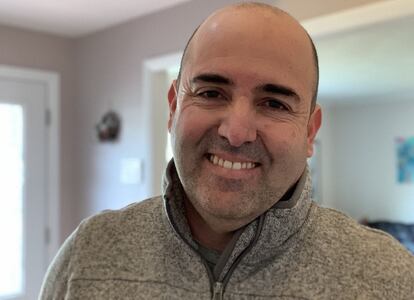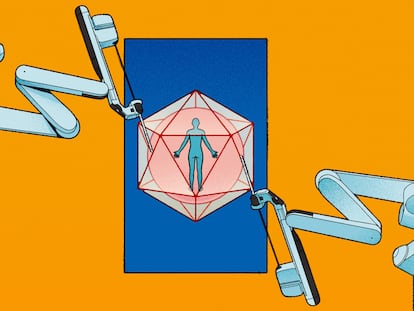The scientist who fled Cuba and played a key role in Moderna’s Covid-19 vaccine
Rolando Pajón, the company’s new medical director for Latin America, explains how he fled to Canada and ended up contributing to the fight against coronavirus

In 2007, Noelia Álvarez, 82, was the only person who knew that her grandson would never return from his trip to Canada. Rolando Pajón was born in Havana, Cuba, just 50 years ago but it has been 15 years since he last set foot in the city – the price that those who “betray” the Cuban regime expect to pay for their freedom.
It was a biomedical project in the western Canadian city of Calgary that offered him the chance to escape, later leading to a new life in the United States and a vital role in the development of Moderna’s vaccine against the coronavirus.
Pajón has just been named the company’s medical director for Latin America. He does not yet know whether he will move to a country in the region or stay in Boston, where he eventually settled after spending time in California, and where he formed a family with a Cuban woman who left the island some time before him.
When asked what he would say to those who don’t trust the Covid-19 vaccines, Pajón replies that “there is a human dimension that is often overlooked. Our family members, friends, acquaintances and we ourselves were going to be vaccinated [his own wife received the shot]. At what point would one of us develop a vaccine that we wouldn’t be willing to give to our own family members? Because, when we work, we think about saving humanity, of course, but also about saving our father or grandmother.”
Noelia, Pajón’s own grandmother, did not get to witness his involvement in the discovery of the vaccine. She passed away in 2015, long before the pandemic. But Pajón still gets emotional when he remembers her: “She was my number one fan,” he says.
Pajón grew up with his grandparents in Bauta, on the outskirts of the capital. It was a “very, very, very, very, very modest” family, he says, although he got a good education thanks to Cuba’s system of schools for talented children. After graduating from university, he led a research team at Cuba’s Center for Genetic Engineering and Biotechnology, one of the most important in the Latin American region.
Vaccines had always been one of his main areas of interest. Before leaving Cuba, he worked on a vaccine against meningococcus, the bacteria that causes meningitis, and in his spare time he wrote children’s books on popular science that earned him several prizes: Alejandro and the mutants, Alejandro and the vaccines and Alejandro and the bacteria.
“We had a research project on our hands that could not be developed in Cuba because we needed a specific reagent that was not readily available,” says Pajón. “I established a collaboration with a scientist from the University of Calgary precisely for that purpose. I tried to get a member of my team to go, but no one could get permission. So I had to go myself.”
When he boarded the plane, Pajón had already decided that he would not return. The only person he told was his grandmother. He did not tell his then ex-wife or his two daughters, who were only four and one-and-a-half years old at the time. “It was a very big decision,” he says. “I didn’t know if I would ever go back to see my grandmother, who was already old, and I assumed that many years would go by before I could hug my girls again, because the government doesn’t allow your family to travel or you to return; you are considered a traitor. But I knew that my future was not in a country like Cuba.”
Pajón carried out the experiments, sent the results back home but stayed in Calgary where he spent two years “working non-stop.” He was obsessed with doing something useful. “There are a lot of researchers in this field who never see their work result in a vaccine,” he says. “We’re great at making vaccines for mice. And curing cancer in them, but I was seeking to make a real impact.” Together with a colleague, he began studying new vaccine candidates against human respiratory pathogens, taking them out of the experimental phase with mice and into the realm of human proof of concept.
Covid-19 was still more than a decade away, but the steps Pajón was taking were decisive in making him one of the protagonists of one of the most effective vaccines against SARS-CoV-2. He signed a contract with Moderna in 2018 to work on flu vaccines that used the revolutionary messenger RNA technology, and within two years, the pandemic struck.
“I was the leader of a team that developed all the tests that measure the immune response and the safety of the vaccine,” he says. In the Phase 3 trial, the one prior to approval, Pajón’s task was to check that everything was going as it should with the more than 30,000 individuals participating in the study: “This involves organizing the samples, doing the analyses, generating the data, checking that the antibodies in our vaccine are neutralizing the virus in such a large population,” he explains. “All in all, it’s a very complex system, involving a very large team. And I was leading that team.”
Pajón realized they were onto something several months after Phase 1 of the clinical trial, which was started in March 2020 with a limited number of participants and a goal to measure the immune response and to prove that the vaccine didn’t produce significant adverse reactions. “Very late at night in May or June, we met our colleagues to study the data,” he says. “It was one of the most encouraging days of the process because we saw that the antibodies were able to neutralize the coronavirus.”
But it took months to confirm the data. Phase 2 and 3, which verify that what works in the lab also works in real life on thousands of people, were still to be undertaken. It wasn’t until November 2020 that the data was presented to the US health authorities. Pajón felt confident they would be accepted.
“The data we had was very, very consistent,” he says. “We knew that the vaccine had 95% efficacy in limiting infection at that time. It was a super-exciting moment, one of the happiest days of my life. But it was also a difficult day because we knew our vaccine worked, but we also knew we didn’t have enough for everyone.”
Almost a year and a half has passed since then and there are still more than 2.8 billion people who have not received a single jab; some because they have refused, but most because the vaccines have not yet reached their countries in sufficient quantities. One of Pajón’s objectives is to bring this technology to the Latin American countries that still have largely unvaccinated populations, in addition to establishing Moderna in the region and making messenger RNA technology accessible to its doctors and laboratories.
Noelia is often in Pajón’s thoughts; he knows she would have been proud of him. Although she was not around to see the peak of her grandson’s career, she did see him again before she died. As Noelia’s father was originally from Spain, she was able to obtain Spanish nationality, which she did in 2010. This allowed her to leave Cuba on a couple of occasions to meet her grandson. So did Pajón’s daughters, whom he saw six and a half years after escaping from Cuba.
Tu suscripción se está usando en otro dispositivo
¿Quieres añadir otro usuario a tu suscripción?
Si continúas leyendo en este dispositivo, no se podrá leer en el otro.
FlechaTu suscripción se está usando en otro dispositivo y solo puedes acceder a EL PAÍS desde un dispositivo a la vez.
Si quieres compartir tu cuenta, cambia tu suscripción a la modalidad Premium, así podrás añadir otro usuario. Cada uno accederá con su propia cuenta de email, lo que os permitirá personalizar vuestra experiencia en EL PAÍS.
¿Tienes una suscripción de empresa? Accede aquí para contratar más cuentas.
En el caso de no saber quién está usando tu cuenta, te recomendamos cambiar tu contraseña aquí.
Si decides continuar compartiendo tu cuenta, este mensaje se mostrará en tu dispositivo y en el de la otra persona que está usando tu cuenta de forma indefinida, afectando a tu experiencia de lectura. Puedes consultar aquí los términos y condiciones de la suscripción digital.
More information
Últimas noticias
Most viewed
- Reinhard Genzel, Nobel laureate in physics: ‘One-minute videos will never give you the truth’
- Oona Chaplin: ‘I told James Cameron that I was living in a treehouse and starting a permaculture project with a friend’
- Pablo Escobar’s hippos: A serious environmental problem, 40 years on
- Chevy Chase, the beloved comedian who was a monster off camera: ‘Not everyone hated him, just the people who’ve worked with him’
- Why we lost the habit of sleeping in two segments and how that changed our sense of time











































